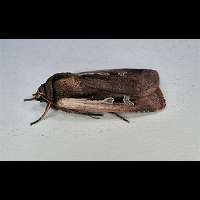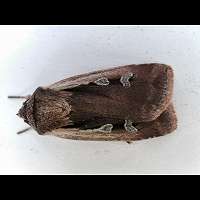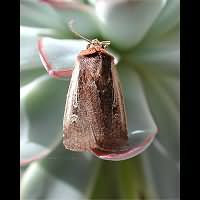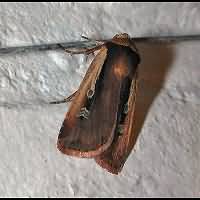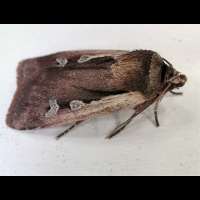Flame Shoulder Ochropleura plecta
The Flame Shoulder is a rather unmistakable Noctuid. The basic colour varies from reddish brown to greyish brown. Along the front edges of the forwings runs a light whittish greyish line, followed by a very dark smear. Within the dark smear are the silvry white kidney marks and round marks. Except for a few faint markings near the edge of the wing the remainder of the wings is extremely plain. The hindwing is greyish. The only similar species is Radford's Flame Shoulder, but this is an extremely rare immigrant. The species can best be told apart by looking at the hindwings, which are brighter white in the case of Radford's Flame Shoulder. Reaching a wingspan of some 35 mm the Flame Shoulder is a rather small species.
Usually the second brood deposits the eggs in August and September. The eggs hatch very quickly and the larvae grow quickly as well. By the end of October they'll dig a small hole in the ground. In this hole they spin a cocoon in which pupation takes place. It is the pupa overwintering. In April the first fresh moths can be seen. The caterpillar is extremely difficult to find. It feeds during the night and hides among low growing plants during the day. It is not very striking at all. Usually it is light brown, sometimes greenish brown. The dorsal line is dark and on each side run two very tiny whitish lines. The head is orange brown, often a good characteristic. The larva of the Flame Shoulder varies from 32 to 35 mm in length. It feeds on low growing plants exclusively, including dandelion, knotgrass, groundsels and plantains. In agriculture uncommonly a pest in beets.
The Flame Shoulder only flies by night, but is attracted to flowers in gardens and to light. Can be found all over Britain, including Orkney and the Outer Hebrides. It has three broods in Southern Europe, is double-brooded in Central Europe, including England, Ireland and Wales. In Northern Europe, such as Scotland and Scandinavia it is single-brooded. Even though the Flame Shoulder is a resident in Central and Northern Europe, numbers are reinforced by immigrants from the south in spring and summer. Some animals probably even migrate back to Southern Europe in autumn.
In the USA the Flame-shouldered Dart is found. For a long time it was believed to be the same species, but in 1998 it was established to be a different species: Ochropleura implecta. Many books and web sites still call it the Flame Shoulder (Ochropleura plecta), though.
The Flame Shoulder is a rather unmistakable Noctuid. The basic colour varies from reddish brown to greyish brown. Along the front edges of the forwings runs a light whittish greyish line, followed by a very dark smear. Within the dark smear are the silvry white kidney marks and round marks. Except for a few faint markings near the edge of the wing the remainder of the wings is extremely plain. The hindwing is greyish. The only similar species is Radford's Flame Shoulder, but this is an extremely rare immigrant. The species can best be told apart by looking at the hindwings, which are brighter white in the case of Radford's Flame Shoulder. Reaching a wingspan of some 35 mm the Flame Shoulder is a rather small species.
Usually the second brood deposits the eggs in August and September. The eggs hatch very quickly and the larvae grow quickly as well. By the end of October they'll dig a small hole in the ground. In this hole they spin a cocoon in which pupation takes place. It is the pupa overwintering. In April the first fresh moths can be seen. The caterpillar is extremely difficult to find. It feeds during the night and hides among low growing plants during the day. It is not very striking at all. Usually it is light brown, sometimes greenish brown. The dorsal line is dark and on each side run two very tiny whitish lines. The head is orange brown, often a good characteristic. The larva of the Flame Shoulder varies from 32 to 35 mm in length. It feeds on low growing plants exclusively, including dandelion, knotgrass, groundsels and plantains. In agriculture uncommonly a pest in beets.
The Flame Shoulder only flies by night, but is attracted to flowers in gardens and to light. Can be found all over Britain, including Orkney and the Outer Hebrides. It has three broods in Southern Europe, is double-brooded in Central Europe, including England, Ireland and Wales. In Northern Europe, such as Scotland and Scandinavia it is single-brooded. Even though the Flame Shoulder is a resident in Central and Northern Europe, numbers are reinforced by immigrants from the south in spring and summer. Some animals probably even migrate back to Southern Europe in autumn.
In the USA the Flame-shouldered Dart is found. For a long time it was believed to be the same species, but in 1998 it was established to be a different species: Ochropleura implecta. Many books and web sites still call it the Flame Shoulder (Ochropleura plecta), though.

